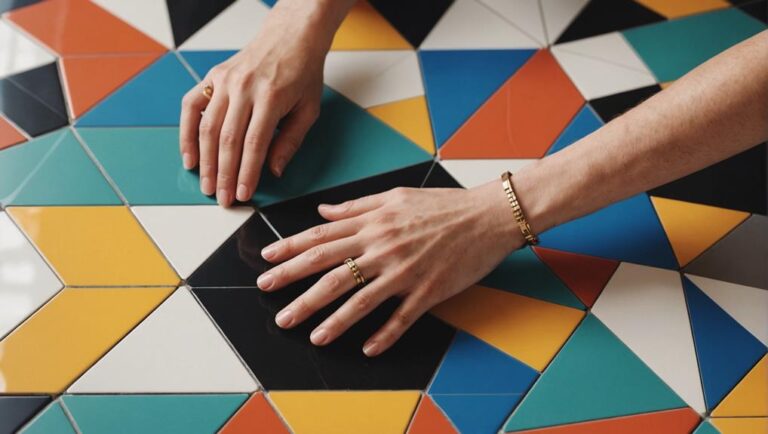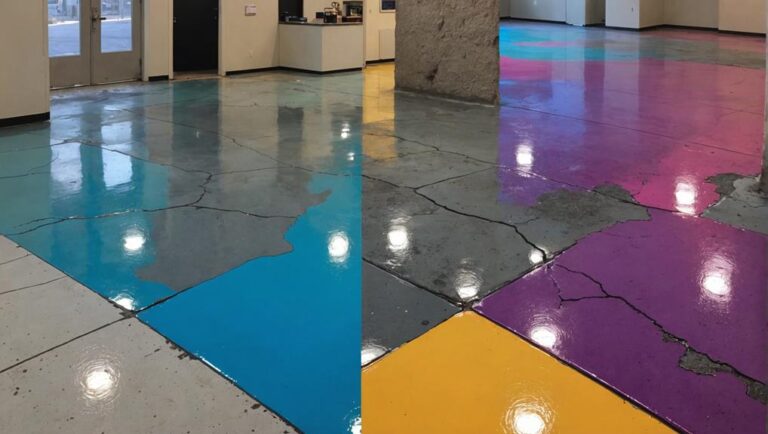Rubber flooring is an excellent choice for wet and high-humidity areas due to its slip-resistant surfaces and superior moisture resistance. Ideal for spaces like commercial kitchens and indoor pools, it helps prevent slips and falls while minimizing mold growth. The non-porous material is easy to maintain and durable enough to withstand heavy foot traffic and spills. Additionally, its comfort features reduce fatigue, making it suitable for long hours of use. You'll find various aesthetic options, ensuring it meets both safety and design needs beautifully. There's more to discover about its installation and customization benefits as you explore further.
Advantages of Rubber Flooring
Rubber flooring offers numerous advantages, particularly in wet areas like bathrooms and kitchens. One primary benefit is its slip-resistance. The textured surface of rubber provides excellent traction, markedly reducing the risk of slips and falls—a vital factor in maintaining safety in high-humidity environments. Moreover, rubber flooring is waterproof, preventing water damage and mold growth, which can pose health risks.
Another advantage is its cost effectiveness. While the initial investment may be higher than some alternatives, rubber flooring's durability and low maintenance requirements lead to long-term savings. It can withstand heavy foot traffic without considerable wear and tear, meaning you won't need to replace it frequently. Cleaning is straightforward, requiring only regular sweeping and occasional mopping.
The environmental impact of rubber flooring is also worth mentioning. Many rubber flooring products are made from recycled materials, reducing waste and promoting sustainability. This choice not only lowers the carbon footprint associated with new materials but also contributes to a greener environment. Additionally, rubber is often manufactured without harmful chemicals, making it a safer option for indoor spaces.
Ideal Applications
When considering rubber flooring, think about its suitability for commercial kitchen environments and indoor pool areas. These spaces require flooring that can handle moisture while providing slip resistance and durability. By choosing rubber, you're ensuring safety and functionality in high-traffic, wet conditions.
Commercial Kitchen Environments
In commercial kitchen environments, flooring must withstand heavy foot traffic, spills, and the constant challenge of maintaining hygiene. Rubber flooring is an ideal solution for these spaces due to its superior durability and slip-resistant properties. When you choose rubber, you're investing in a material specifically designed to handle the rigors of a bustling kitchen while ensuring kitchen safety.
This flooring type can endure the daily wear and tear from heavy equipment and constant movement, making it an excellent choice for high-impact areas. Its non-porous surface helps prevent bacterial growth, which is vital for maintaining sanitary conditions. Additionally, rubber flooring is easy to clean, allowing you to maintain hygiene effortlessly.
Another important factor is the flooring's ability to absorb shock, reducing fatigue for staff who spend long hours on their feet. This characteristic contributes to a safer work environment, minimizing the risk of slips and falls. You'll appreciate the peace of mind that comes with knowing your kitchen flooring can withstand spills and heavy usage while promoting a safe and efficient workspace. To summarize, rubber flooring combines flooring durability with essential safety features, making it the perfect choice for commercial kitchens.
Indoor Pool Areas
Choosing rubber flooring continues to be advantageous in environments where moisture is prevalent, such as indoor pool areas. This type of flooring is designed to provide excellent slip resistance, which is essential for maintaining pool safety. With water always present, the risk of slips and falls increases considerably, making the right flooring choice critical.
Rubber flooring not only enhances safety but also aligns with modern design trends. Available in various colors and textures, it can easily complement your pool area's aesthetic while providing a comfortable surface for bare feet. The cushioning effect of rubber minimizes fatigue for those spending extended periods near the pool, promoting a more enjoyable environment.
Additionally, rubber flooring is durable and low-maintenance, resisting mold and mildew—common concerns in high-humidity areas. Its waterproof properties guarantee that water doesn't penetrate, reducing the risk of damage and promoting longevity.
When selecting flooring for your indoor pool area, prioritize options that maximize pool safety while adhering to current design trends. By doing so, you'll create a visually appealing and safe space for all users, enhancing the overall experience in your indoor pool environment.
Moisture Resistance Features
When choosing rubber flooring for wet areas, you'll want to evaluate its moisture resistance features. The materials used are typically water-resistant, minimizing absorption and damage. Additionally, many options offer anti-fungal properties and a slip-resistant surface, ensuring safety and durability in humid conditions.
Water-Resistant Materials
Although many flooring options struggle in wet conditions, rubber flooring stands out due to its superior water-resistant materials. This flooring type is designed with inherent properties that repel moisture, making it ideal for wet and high-humidity areas. One of the key features is its use of waterproof coatings that provide an additional barrier against water, enhancing durability and safety.
To further improve safety, rubber flooring often integrates effective drainage solutions. These solutions allow water to flow away from the surface, reducing the risk of slips and falls.
Here's a quick overview of the benefits of rubber flooring in wet areas:
| Feature | Benefit | Safety Impact |
|---|---|---|
| Waterproof Coatings | Prevents water absorption | Reduces mold and mildew risks |
| Drainage Solutions | Encourages quick water runoff | Minimizes slip hazards |
| Slip-Resistant Surface | Enhances grip even when wet | Decreases chances of accidents |
Choosing rubber flooring for areas prone to moisture guarantees not only longevity but also a safer environment for users. You'll appreciate the peace of mind that comes from knowing your flooring can handle wet conditions effectively.
Anti-Fungal Properties
Rubber flooring not only excels in resisting moisture but also boasts impressive anti-fungal properties. This makes it an ideal choice for environments prone to high humidity, where mold and mildew can pose significant health risks. Utilizing rubber flooring helps guarantee that you maintain hygiene standards, essential for areas like bathrooms, kitchens, and gyms.
Here are some key benefits of rubber flooring regarding mold prevention:
- Natural Resistance: Rubber inherently resists mold growth, making it less likely to harbor harmful fungi.
- Easy Maintenance: Its smooth surface allows for easy cleaning, reducing the chance of mold spores settling.
- Durability: Rubber flooring is designed to withstand wear and tear, maintaining its anti-fungal properties over time.
Slip-Resistant Surface
In environments where water exposure is a constant concern, having a slip-resistant surface becomes essential for safety. Rubber flooring is specifically engineered to meet safety standards that address slipping hazards, providing you with a reliable solution in high-humidity areas like bathrooms, kitchens, and pool decks.
The slip-resistant properties of rubber flooring are a result of its unique texture and material composition. This design guarantees that even when wet, the surface maintains adequate traction, reducing the risk of accidents. Many manufacturers conduct traction testing to verify the effectiveness of their products, confirming they meet or exceed established safety benchmarks.
When choosing rubber flooring, look for options that have undergone rigorous testing and have certifications to back their claims. This not only assures you of compliance with safety standards but also provides peace of mind knowing that your flooring choice actively contributes to a safer environment.
Slip Resistance Benefits
When it comes to flooring in wet areas, guaranteeing slip resistance is crucial for safety. You want a surface that not only meets but exceeds safety standards, helping to prevent accidents in high-humidity environments. Rubber flooring is engineered to provide superior slip resistance, making it an excellent choice for spaces like bathrooms, kitchens, and pool areas.
Here are some key benefits of rubber flooring's slip resistance:
- Enhanced Traction: The textured surface of rubber flooring increases grip, reducing the likelihood of slips and falls.
- Compliance with Safety Standards: Many rubber flooring options undergo performance testing to verify they meet stringent safety regulations, giving you peace of mind.
- Durability: Rubber is resilient and maintains its slip-resistant properties over time, even in challenging conditions.
Choosing rubber flooring that complies with safety standards means you're investing in a product that has been rigorously tested for slip resistance. The inherent properties of rubber allow for a flexible yet firm surface, which contributes to overall traction. With performance testing confirming its efficacy, you can be confident that you're selecting a flooring option designed to keep you safe.
In high-humidity areas, where moisture can create hazardous conditions, rubber flooring's slip resistance isn't just a feature; it's a necessity. By prioritizing slip resistance in your flooring choice, you're actively fostering a safer environment for everyone.
Maintenance and Care
Proper maintenance is essential to secure the longevity and performance of rubber flooring in wet areas. To achieve long-term durability, you'll need to implement effective cleaning techniques regularly. Start by sweeping or vacuuming the surface to remove dirt and debris, as accumulated particles can cause scratches and reduce traction.
For deeper cleaning, use a damp mop with a pH-neutral cleaner specifically designed for rubber flooring. Avoid harsh chemicals or abrasive tools, as they can damage the surface. It's advisable to clean spills immediately to prevent moisture from seeping into seams, which can lead to mold and mildew growth.
Once a month, consider using a specialized rubber floor cleaner to maintain its appearance and functionality. This not only enhances the floor's aesthetic but also helps preserve its slip-resistant properties. Additionally, inspect the flooring periodically for any signs of wear, such as tears or discoloration, and address these issues promptly to prevent further damage.
In high-humidity areas, guarantee proper ventilation to minimize moisture accumulation, which can compromise the rubber's integrity over time. You might also want to utilize mats at entry points to further reduce water exposure.
Installation Considerations
Before laying rubber flooring in wet areas, there are several key installation factors to keep in mind. Proper installation techniques and thorough subfloor preparation are vital for guaranteeing safety and longevity in high-humidity environments. Here are a few essential points to take into account:
- Moisture Testing: Always test the subfloor for moisture levels before installation. Excess moisture can lead to mold growth and compromise the flooring's integrity.
- Surface Leveling: Confirm that the subfloor is smooth, clean, and free of defects. Any imperfections can affect the performance and durability of the rubber flooring.
- Adhesive Selection: Use a high-quality adhesive specifically designed for rubber flooring in wet areas. This provides a secure bond and enhances the flooring's resistance to moisture.
When preparing the subfloor, you'll want to address any cracks or inconsistencies, as these can create weak spots in your flooring. If you're working with concrete, allow it to cure completely before installation. Also, think about using a moisture barrier if you're concerned about water intrusion.
During installation, follow the manufacturer's guidelines closely, as they often provide specific recommendations for their products. Proper acclimation of the rubber material is also essential, allowing it to adjust to the room's temperature and humidity levels. By paying attention to these details, you can guarantee a safe, effective installation that stands up to the challenges of wet environments.
Aesthetic Options and Customization
Rubber flooring offers a diverse range of aesthetic options and customization features that can enhance the visual appeal of wet areas. When you're selecting flooring for environments like bathrooms, kitchens, or locker rooms, you'll find that safety and design can go hand in hand. One of the most significant advantages is the variety of color choices available. Whether you prefer vibrant hues or subtle earth tones, you can select a color that complements your space while ensuring visibility and safety.
Beyond color, pattern variations can also play an important role in the overall aesthetic. Textured surfaces and unique patterns not only provide visual interest but also enhance slip resistance, an essential factor in wet areas. You can choose from speckled designs, marbled looks, or even interlocking tiles that allow for creative layouts.
Customization extends to the thickness and surface finish of the rubber flooring, which can help you meet specific safety standards while achieving the desired look. For instance, a smooth finish might be easier to clean, while a textured finish can improve traction.
Frequently Asked Questions
How Does Rubber Flooring Compare to Other Wet-Area Flooring Options?
Did you know that 70% of slips and falls occur in wet areas? When comparing rubber flooring to other options, you'll find its durability stands out, often lasting longer than vinyl or tile. Plus, maintenance requirements for rubber are generally lower, needing just regular cleaning to prevent buildup. This combination of durability and ease of upkeep makes rubber a safer choice for wet environments, helping to minimize hazards while providing long-lasting performance.
Is Rubber Flooring Suitable for Outdoor Wet Environments?
Yes, rubber flooring can be suitable for outdoor wet environments, but you need to take into account installation methods carefully. Guarantee proper drainage to prevent water pooling, which can lead to safety hazards. For maintenance, regularly clean the surface to avoid mold and mildew buildup, and inspect for wear. Using textured rubber flooring can enhance grip, reducing slip risks. Always prioritize safety by selecting high-quality materials designed for outdoor use.
Can Rubber Flooring Be Recycled or Disposed of Environmentally?
Yes, rubber flooring can be recycled, and there are eco-friendly options available. Many recycling processes break down used rubber into granules or new products, reducing landfill waste. You should check with local recycling centers or manufacturers for specific guidelines. Additionally, some companies offer take-back programs, ensuring safe disposal and promoting sustainability. When choosing rubber flooring, consider its recyclability to contribute to a greener environment while maintaining safety in your space.
What Is the Lifespan of Rubber Flooring in High-Humidity Areas?
The lifespan of rubber flooring in high-humidity areas typically ranges from 10 to 20 years, depending on installation techniques and maintenance practices. Proper installation can help prevent moisture-related issues, while regular maintenance, such as cleaning and inspections, guarantees durability. It's essential to choose high-quality materials and follow manufacturer guidelines for best results. By prioritizing these factors, you can enhance the flooring's longevity and safety in challenging environments.
Are There Any Health Concerns Associated With Rubber Flooring Materials?
You'd think rubber flooring could be a health hazard lurking in the shadows, but it's generally safe! In fact, many rubber materials offer significant health benefits, like reducing allergens and providing a cushioned surface. However, it's crucial to verify the material safety of the products you choose. Some low-quality rubber can emit volatile organic compounds (VOCs), so always opt for certified, high-quality flooring to maintain a safe environment for you and your family.




